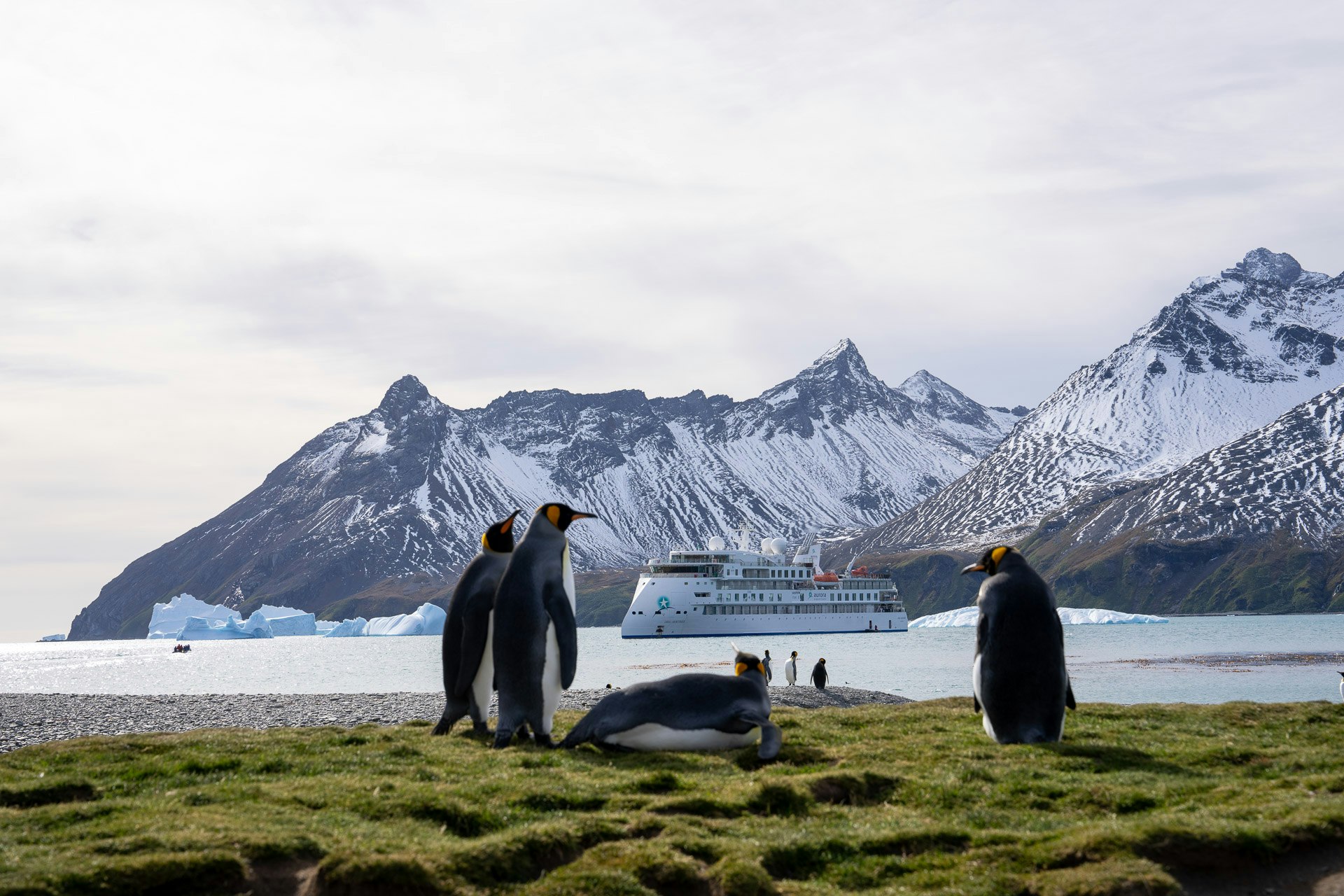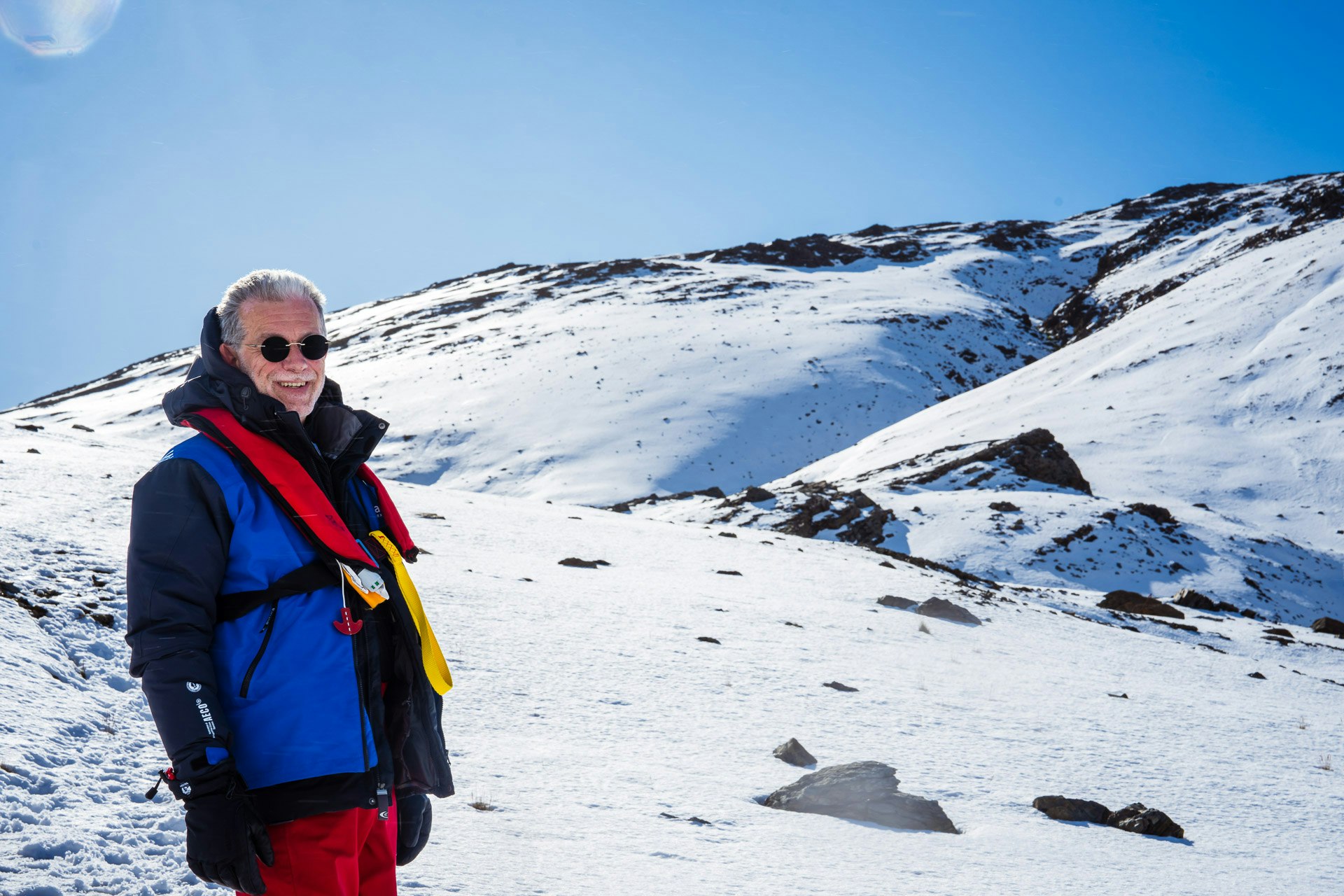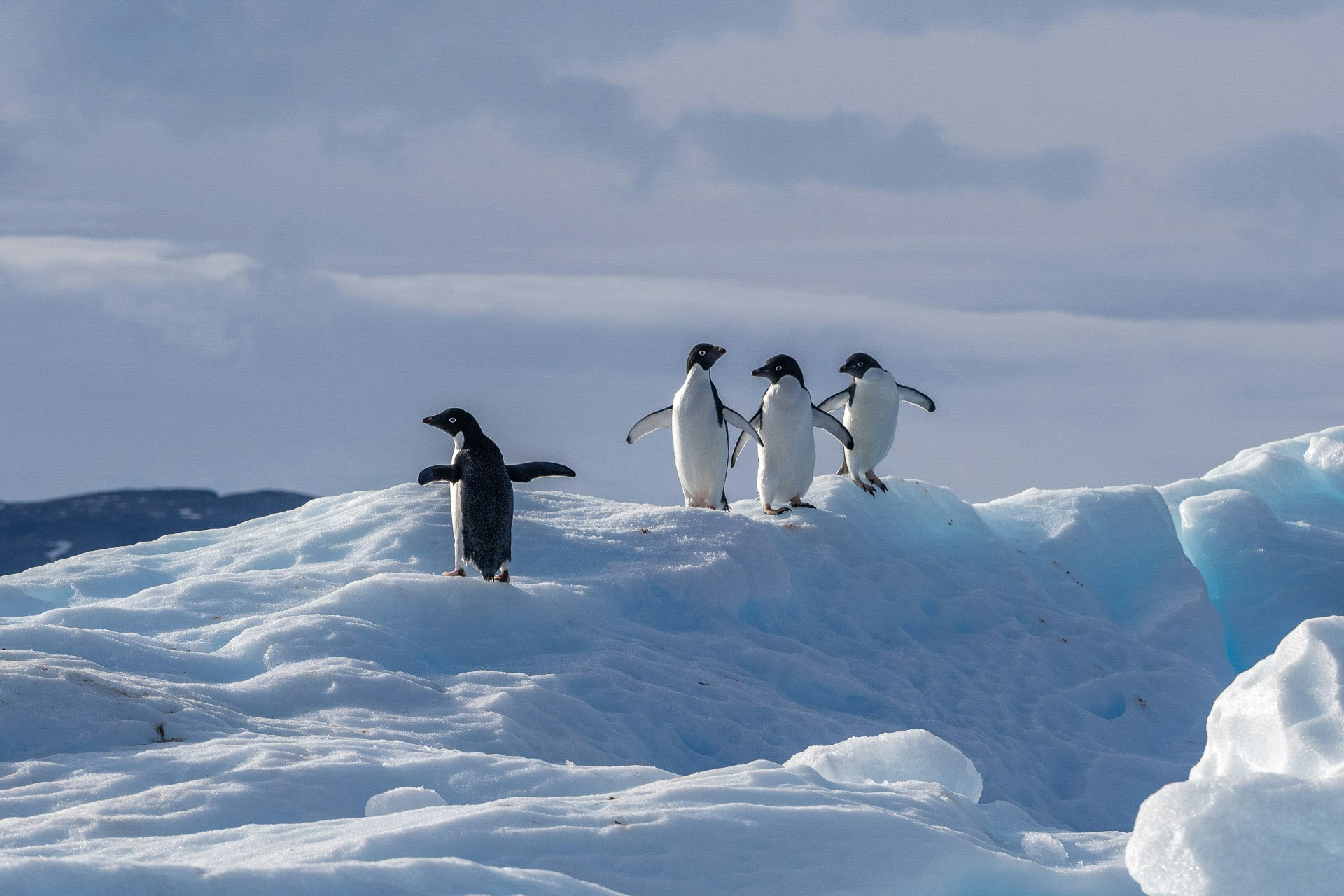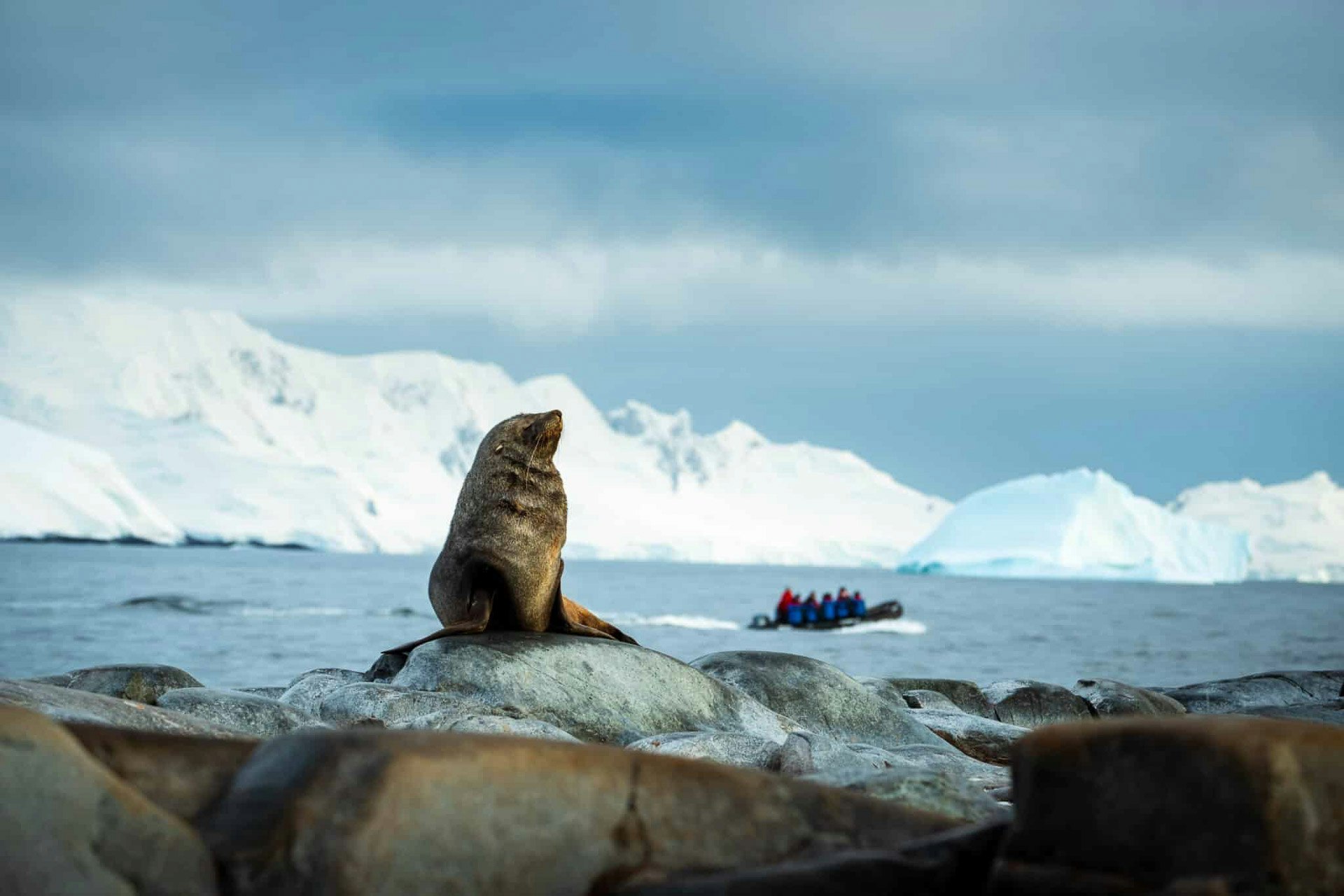An Antarctic Peninsula expedition is the classic way to experience the white continent and the first taste of Antarctica for most expeditioners.
An Antarctic Peninsula expedition is the classic way to experience the white continent and the first taste of Antarctica for most expeditioners. The Antarctic Peninsula forms a 1,300 kilometre (800 miles) northward extension of Antarctica towards the southern tip of South America. With a mountain range that extends for more than half its length, and peaks approaching 3,000 metres (9842 feet), the Peninsula offers some of the most dramatic scenery in Antarctica.
Home to a large selection of Antarctic wildlife, with numerous species of seals, penguins and whales. Experience stepping foot on the 7th continent, Zodiac cruising past tabular icebergs to mammoth glacier fronts observing the ice calving, and visit historic sites including the most southerly post office in the world.

Antarctic Peninsula Expeditions 2025, 2026 & 2027
Spirit of Antarctica
Antarctica Active: All Inclusive Activities
Taste of Antarctica
Antarctica Complete
Antarctic Peninsula Cruise Wildlife Encounters
Penguins
Experience the incredible diversity of penguin species that call the Antarctic Peninsula home. Gentoo, chinstrap, and Adélie penguins thrive in colonies across this icy landscape. Our expert expedition leaders will share fascinating insights into their behaviors, survival strategies, and the unique challenges they face in this extreme environment.
Seals
Zodiac cruise or kayak in search of leopard seals on ice floes, be delighted by fur seals swimming playfully near your vessel, fall in love with Weddell seals’ puppy-dog eyes, and learn about the recovery of the elephant seal population after they were prized by sealers for decades.
Whales
Antarctic Peninsula cruises offer a unique opportunity to witness some of the most magnificent creatures on earth – whales. The waters around the peninsula are home to several species of whales, including the humpback whale, the minke whale and the orca, also known as the killer whale. Search for whales in the icy bays and witness their tail flukes as they dive to feed on krill. These gentle giants can often be seen swimming close to the ship, putting on a spectacular show for lucky spectators. The experience of witnessing these majestic creatures in their natural habitat is truly unforgettable and is one of the highlights of any Antarctic Peninsula expedition.
Seabirds
Our Antarctic Peninsula cruises are an incredible opportunity to witness a diverse array of fascinating seabirds in their natural habitat. Among the species that expeditioners may encounter are the majestic wandering albatross, famous for its impressive wingspan, the elegant snow petrel, whose snowy plumage blends seamlessly with the icy landscape, and the playful Antarctic tern. Other species that may be spotted include the southern giant petrel, the Antarctic shag, and the strikingly beautiful Cape petrel. These birds are not only a joy to observe but also play crucial roles in the Antarctic ecosystem.
Unique Antarctic Peninsula Cruise Experiences
Activities
There is so much more to the Antarctic Peninsula than what is visible above the surface. Explore icy underwater worlds that few get to experience by adding scuba diving, kayaking or snorkelling to your expedition. If these aren’t for you, you will still have the chance to immerse yourself in polar waters and earn the ultimate bragging rights by participating in a polar plunge.
If you choose an expedition cruise early in the season, you can choose to spend a night camping under Antarctica’s pastel skies, listening to the uninterrupted sounds of raw nature – ice cracking and popping all around you, glaciers calving, a whale breaching in the distance… Unsurprisingly, many are too entranced to doze off!
Shore Excursions
After being shuttled to shore, visit penguin rookeries, discover historic huts and explore some of our favourite spots along the Peninsula. Stretch your legs by wandering along pebbly beaches or up snow-covered ridgelines to vantage points with mountains towering overhead and ice-speckled oceans below.
Zodiac Cruising
Not just a mode of transportation, Zodiac cruising in the Antarctic Peninsula is a highlight for many on our Antarctic voyages. Your expert driver will manoeuvre you over sea ice and around beautifully sculpted icebergs to scenic bays and viewpoints of glaciers calving which are not accessible by ship.
The Drake Passage
The fastest way to visit Antarctica by sea is by crossing the Drake Passage, which has become a rite of passage for many polar explorers. Learn about the brave explorers who came before you as you sail the infamous Drake Passage in one or both directions on new, purpose-built expedition ships that were built for these dramatic waters.
Antarctic Peninsula Cruises FAQs
Antarctica is the southernmost continent on Earth. The South Geographic Pole is in Antarctica, and most of the continent lies within the Antarctic Circle, at 66.5 degrees south of the Equator.
Antarctica is so far south that most of the continent receives 24 hours of daylight during summer, and 24 hours of darkness during winter.
Antarctica lies to the south of Australia, New Zealand, South Africa and South America, and is surrounded by the Southern Ocean (also known as the Antarctic Ocean). Most visitors access Antarctica via ship or aircraft from an Antarctic ‘gateway city’. The five official Antarctic gateway cities are Ushuaia (Argentina), Hobart (Australia), Punta Arenas (Chile), Christchurch (New Zealand), and Cape Town (South Africa).
The name ‘Antarctica’ comes from ‘Antarktos’, meaning ‘opposite the Arctic’. Antarctica and the Arctic are indeed opposites in many ways, and they lie at the polar extremes of the globe: the Arctic to the north and Antarctica to the south.
Antarctica is the coldest continent on Earth. The average temperature throughout the year is about -57°C, with the minimum temperature being -130°F (-90°C) during the winter season.
During the summer months, when we visit, the temperature can range from 28°F (-2°C) to 46°F (8°C). In summer, big storms are rare, but if one comes through the temperature could drop to 17°F (-8°C ).
Shipboard attire leans toward the informal and casual side, you’ll find jeans, jumpers, and long-sleeved shirts comfortable indoors. It’s wise to have your jacket within reach for impromptu wildlife encounters.
While there’s no need for formal clothing, some travellers like to dress up for the captain’s welcome and farewell drinks.
Each passenger on our Antarctic cruises will receive an expedition jacket. Though, you should pack suitable cold and wet weather gear for onshore landings during your Antarctica cruise.
To help you prepare, consult our suggested packing list, which outlines the recommended types of layers and materials for an Antarctica cruise.
Antarctica is home to a hardy community of wonderful wildlife, which has adapted to the cold, windy and icy Antarctic environment.
There are four species of penguins in Antarctica. They are the emperor, Adélie, gentoo and chinstrap. The emperor and Adélie penguins are found only in Antarctica.
There are six species of Antarctic seals: Ross seals, Weddell seals, crabeater seals, leopard seals, southern fur seals and southern elephant seals. They all live in the ocean surrounding Antarctica, hauling out on ice or land to rest and pup.
Many whales visit Antarctic waters during the summer feeding season between late October and early April. The whales that commonly visit Antarctic waters include humpback whales, killer whales, minke whales, fin whales, sei whales and even the enormous blue whale!
In addition to these charismatic creatures we see on the ocean’s surface, the Antarctic ocean is filled with a rich variety of sea life, from single-celled algae, which form the foundation of the Antarctic food web, to krill, a tiny crustacean which is a keystone species in the Antarctic ecosystem, providing sustenance for seals, whales, penguins and many other seabirds.
Most animals that thrive in Antarctica are marine animals. This means that they rely on the ocean and marine ecosystems to survive and thrive. However, there are a few Antarctic animals that live entirely on land. These include the microscopic springtails, nematodes and tardigrades, which live amongst moss and lichen in areas which are not permanently snow-covered.
The cost of an Antarctica cruise can vary significantly, influenced by factors such as voyage duration, stateroom type, and the chosen itinerary.
When considering an Antarctica cruise with Aurora Expeditions, you can expect prices to start from USD$13,195 per person when sharing a twin Aurora Stateroom. However, there are also early bird discounts available.
How long is an Antarctica cruise?
Antarctica cruises typically last between 9 to 34 days, with most cruises ranging from 12 to 21 days. The duration depends on factors such as departure location and itinerary. Shorter trips focus on highlights, while longer voyages explore more remote regions.
You can reach Antarctica from the southern tip of South America or from 2025, start your trip from Hobart, Australia or Dunedin, New Zealand. Two popular departure points for Antarctica cruises are Ushuaia, Argentina, and Punta Arenas, Chile, both located in the Patagonian region and are among the southernmost towns on Earth.
Antarctica cruises commencing in Ushuaia typically involve crossing the Drake Passage to reach the Antarctic Peninsula or voyaging to the Subantarctic Islands of the Falklands or South Georgia before continuing onward to Antarctica.
Alternatively, passengers departing from Punta Arenas can enjoy a unique experience by flying to Antarctica, specifically King George Island, via a charter flight arranged exclusively for their expedition.
Children are more than welcome on our Antarctica cruises. However, we recommend that they are at least 8 years old and must travel with their legal guardian. Children pay the same rate as an adult traveller.
Although you cannot swim in Antarctica, most of our voyages stop for a ‘Polar Plunge’, where all willing passengers can take the ultimate dip into the icy Antarctic waters. You do have the option to take up our Polar Snorkelling activity, or experienced scuba divers have the option to dive, on selected voyages. Additional charges may apply.
Are there any health considerations for travellers visiting Antarctica?
Travellers planning a visit to the Antarctic Peninsula should consult their healthcare provider for guidance on necessary vaccinations and health precautions.
Good health and physical preparedness are crucial for the demands of the expedition.
Aurora Expeditions requires passengers to submit a signed medical form from their healthcare provider during the booking process.
Travellers must adhere to environmental protection guidelines and practice responsible tourism to safeguard Antarctica’s delicate ecosystem throughout their cruise.









































